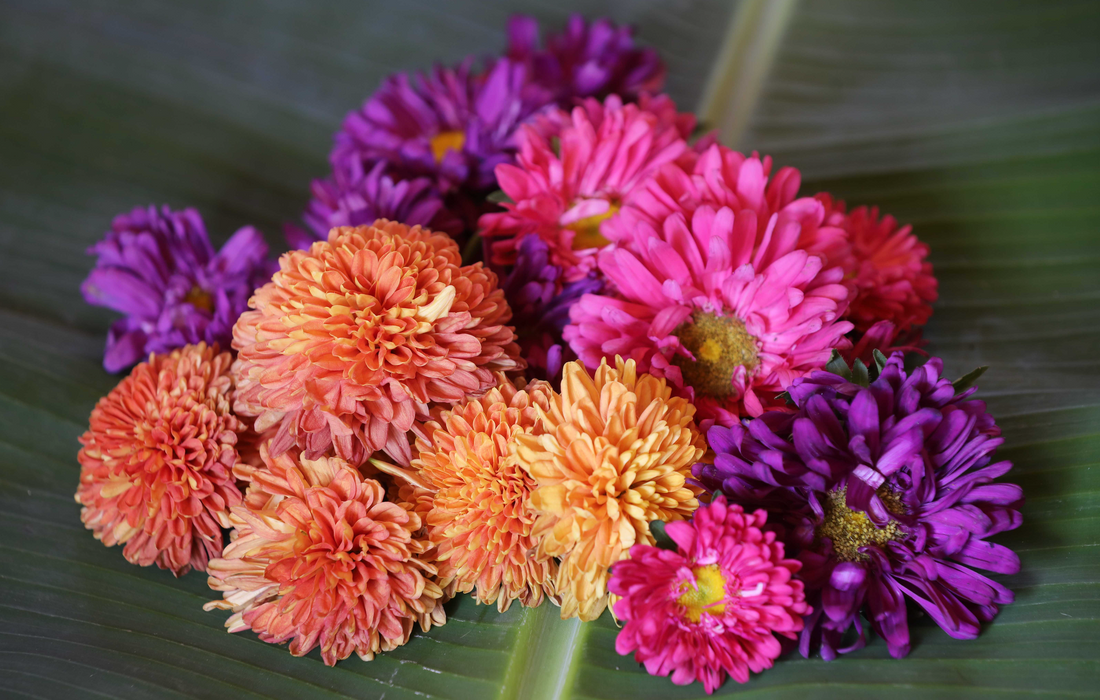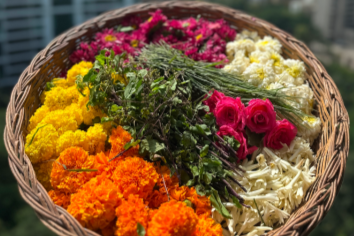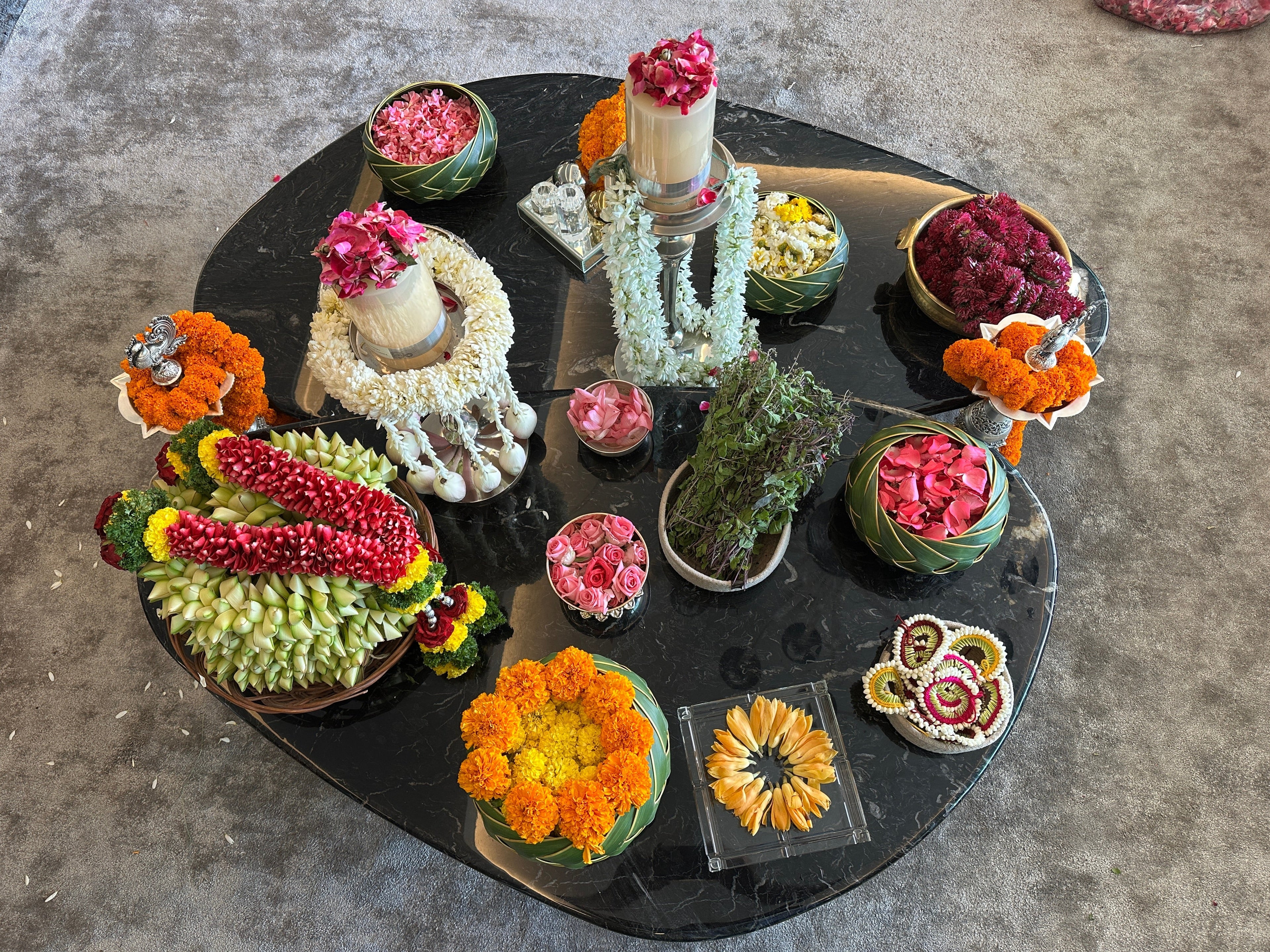
I still remember my grandmother's gentle scolding when I tried to reuse yesterday's marigolds for morning pooja. "The gods don't accept stale offerings," she said, removing the wilted blooms from my hands. At the time, it seemed like just another ritual rule, but years later, I've come to understand the profound wisdom behind her insistence on freshness.
The tradition of offering fresh flowers in Hindu worship isn't merely aesthetic preference—it represents a sophisticated understanding of energetic properties that modern science is only beginning to comprehend. This comprehensive guide explores why fresh blooms matter spiritually, which flowers to avoid for specific deities, and practical methods to maintain flower freshness for your daily rituals.
Key Takeaways
-
Ancient texts including the Agni Purana specifically mandate fresh flowers for spiritual efficacy
-
Different deities have unique flower preferences and taboos based on traditional associations
-
Fresh flowers produce measurably different biochemical effects compared to wilted or artificial alternatives
-
Simple preservation techniques can extend flower freshness by 8-12 hours without compromising spiritual purity
-
Specific flowers are universally prohibited in worship due to mythological associations or energetic properties
The Spiritual Mandate for Freshness
Ancient Wisdom: What Scriptures Say About Flower Freshness
Hindu scriptures are explicit about the importance of freshness in floral offerings. The Agni Purana states: "Flowers plucked the same day and still containing their natural fragrance please the deities, while those wilted or devoid of scent bring displeasure." Similarly, the Padma Purana emphasizes that flowers should be "gathered at dawn and offered before their essence diminishes."
These aren't arbitrary rules but reflect deep understanding of subtle energies. Fresh flowers embody "sattvic" qualities—purity, harmony, and clarity—that create an appropriate energetic environment for divine communion. Wilted flowers, conversely, contain "tamasic" energy—dullness, inertia, and decay—considered inappropriate for spiritual elevation.
Interestingly, some texts even specify timeframes, suggesting that flowers maintain their spiritual potency for approximately 6-8 hours after harvesting, after which their energetic qualities begin to degrade significantly. This ancient understanding aligns with what we now know about the biochemical changes that occur in cut flowers.
Energetic Properties: Beyond Physical Appearance
The emphasis on freshness extends beyond mere visual aesthetics to the subtle energetic properties flowers contain:
-
Fresh flowers actively release oxygen and beneficial phytoncides during daylight hours
-
They emit specific vibrational frequencies that affect the surrounding environment
-
Their essential oils reach peak potency shortly after harvesting
-
The water content in fresh petals creates electrical conductivity that dissipates as they dry
Temple studies demonstrate that environments containing fresh flowers measurably enhance meditative states, with fresh marigolds showing particular efficacy in increasing devotional focus by up to 40% compared to artificial alternatives.
For deeper insights into the complete journey of flowers from farm to spiritual significance, explore our comprehensive guide Fresh Flowers Decoded: The Complete Ecosystem from Farm to Spiritual Significance.
How to Keep Pooja Flowers Fresh?
Immediate Post-Purchase Care
The moment you acquire flowers—whether from markets or through fresh pooja flowers delivery—proper handling becomes essential:
-
Immediate Water Immersion: Place stems in room-temperature water with a pinch of turmeric (a natural antibacterial)
-
Stem Trimming: Cut 1-2cm from stems at a 45° angle to improve water uptake
-
Leaf Removal: Remove any leaves that would sit below the water line to prevent bacterial growth
-
Temperature Control: Keep flowers in the coolest available location, away from direct sunlight
-
Gentle Handling: Minimize touching the petals, which transfers oils and bacteria
These simple steps can extend freshness by several hours, ensuring your offerings maintain their spiritual potency throughout morning rituals.
How to Keep Pooja Flowers Fresh Overnight?
For those who need to preserve flowers from evening delivery until morning worship, traditional techniques include:
-
Banana Leaf Wrap: Wrap jasmine and similar delicate flowers in banana leaves, which naturally maintain optimal humidity levels and extend freshness by up to 8 hours
-
Clay Pot Storage: Porous earthen pots maintain approximately 65% humidity—ideal for preserving marigolds and roses
-
Water Bath: Floating flowers like marigold heads in a shallow water bowl preserves them effectively
-
Betel Leaf Method: Wrapping in betel leaves, which contain natural preservative compounds
-
Damp Cotton Cloth: Loosely wrapping blooms in slightly dampened cotton fabric in a cool location
What's fascinating is how these traditional methods have been validated by modern research—banana leaves, for instance, naturally contain antimicrobial compounds that inhibit bacterial growth on flower surfaces.
For more guidance on sourcing truly fresh flowers in Pune, see our detailed resource Where to Find the Freshest Flowers in Pune: Complete Guide.
Deity-Specific Flower Selections
Auspicious Offerings for Major Deities
Different deities respond to particular flowers, creating specific energetic connections:
Lord Ganesha favors:
-
Red Hibiscus (removes obstacles)
-
Durva grass (represents triumph over challenges)
-
Yellow Zendu/Marigold (signifies auspiciousness)
Goddess Lakshmi prefers:
-
Lotus (represents prosperity and spiritual awakening)
-
Yellow and orange flowers (symbolizing abundance)
-
Rose (particularly pink and yellow varieties)
Lord Shiva is pleased by:
-
Bael leaves (considered most auspicious)
-
White flowers like jasmine and champa (representing purity)
-
Datura (in specific contexts only, with caution)
Goddess Durga accepts:
-
Red flowers of all varieties (symbolizing power and energy)
-
Aparajita (blue pea flower, representing victory)
-
Marigolds (particularly during Navratri)
Lord Vishnu appreciates:
-
Tulsi leaves (though not the flowers)
-
Yellow flowers like champa and marigold
-
Lotus and lotus seeds
The energetic resonance between specific deities and flowers is so precise that incorrect offerings can actually create disharmony rather than communion, undermining the very purpose of the ritual.
What NOT to Offer: Forbidden Flowers in Hindu Worship
Equally important to knowing appropriate offerings is understanding which flowers to avoid. Several varieties are explicitly prohibited in worship:
-
Ketaki (Pandanus): Forbidden in Shiva worship due to mythological associations with false testimony against the deity
-
Arka/Calotropis: Its milky sap represents impurity, restricted to specific Rahu-Ketu rituals
-
Red Hibiscus: While perfect for Goddess Kali and Ganesha, it's inappropriate for Vishnu and some forms of Shiva
-
Tulsi Flowers: The blossoms (unlike the sacred leaves) are generally avoided in worship
-
Previously Offered Flowers: Once offered to one deity, flowers should never be presented to another
These prohibitions demonstrate the sophisticated understanding of flower energetics in Hindu tradition—recognizing that each bloom carries specific qualities that must align appropriately with the deity being worshipped.
The Science Behind Flower Freshness
Biochemical Changes in Aging Flowers
Modern research provides fascinating insights into why our ancestors emphasized freshness:
-
Cut flowers continue respiration but gradually deplete stored carbohydrates
-
Ethylene production accelerates as flowers age, promoting wilting
-
Water uptake diminishes as stem vessels become blocked with bacteria
-
Essential oil composition changes significantly within 12-24 hours after cutting
-
Beneficial compounds including flavonoids and polyphenols degrade rapidly after harvesting
These changes don't just affect appearance—they fundamentally alter the biochemical impact flowers have on their surroundings and the humans interacting with them.
For an in-depth exploration of the hidden science behind flower benefits, read our article Beyond Beauty: The Hidden Science & Spiritual Power of Fresh Flowers in Everyday Life.
Environmental Impact on Spiritual Potency
Environmental factors dramatically influence a flower's spiritual potency:
-
Growing Conditions: Flowers grown with chemical inputs contain significantly different compound profiles than naturally grown alternatives
-
Harvesting Time: Blooms picked at dawn contain different biochemical properties than those harvested midday
-
Post-Harvest Handling: Each handling stage diminishes the flower's vitality and energetic potency
These insights explain why imported flowers—often harvested days before reaching your altar—lack the spiritual efficacy of locally grown, truly fresh alternatives. Learn more about the importance of ethical, local sourcing in our exploration of The Cut Flower Industry's Dirty Secret & Why Local, Farm-Fresh Flowers Are the Future.
Modern Challenges & Practical Solutions
Daily Fresh Flowers: The Urban Devotee's Dilemma
Modern lifestyles create genuine challenges for maintaining traditional flower practices:
-
Early morning market visits conflict with professional schedules
-
Urban living often means limited access to garden space for growing ritual flowers
-
Market-bought flowers may have been harvested days earlier despite appearing "fresh"
-
Inconsistent quality and availability create disruptions in daily practice
These practical constraints explain why many devotees have sought alternatives, sometimes compromising on the spiritual efficacy of their offerings.
The Subscription Solution: Convenience Meets Tradition
Flower subscriptions represent a modern solution that addresses these challenges without compromising spiritual integrity:
-
Daily delivery of genuinely fresh, locally grown flowers
-
Consistent quality and appropriate varieties for specific deities
-
Flowers harvested within hours rather than days of use
-
Time savings from eliminated market visits
-
Supporting local, ethical growing practices
This approach maintains the essence of tradition while adapting to contemporary realities. For more on how subscriptions are transforming devotional practices, see our analysis of Why Smart Buyers Are Choosing Flower Subscriptions.
Beyond Pooja: Respectful Handling of Sacred Flowers
Post-Worship Treatment of Offered Flowers
After serving their purpose in worship, flowers retain sacred energy and require respectful handling:
-
Never discard in regular trash, which is considered disrespectful
-
Immerse in flowing water such as rivers (avoiding stagnant bodies)
-
Place at the base of sacred trees like Peepal or Banyan
-
Return to garden soil through composting
-
Float in temple tanks where available
This respectful disposal completes the sacred cycle, returning the flowers' elements to nature while honoring their temporary role in connecting human and divine.
Upcycling Sacred Blooms
Some traditions offer creative ways to extend the usefulness of worship flowers:
-
Creating natural dyes from marigold and rose petals
-
Preparing fragrant potpourri from dried jasmine and rose
-
Incorporating into herbal bathing mixtures
-
Using in natural incense production
-
Creating seed paper for auspicious occasions
These approaches maintain respect for the flowers' sacred status while preventing wasteful disposal—a beautiful balance of tradition and sustainability.
FAQ: Common Questions About Pooja Flowers
Can artificial flowers be used for worship?
While artificial flowers may be visually appealing, they lack the essential life force (prana) and biochemical properties that make fresh flowers effective in spiritual practices. Scriptures specifically mention the importance of fragrance and vitality in floral offerings—qualities absent in synthetic alternatives. If fresh flowers are genuinely unavailable, better alternatives include fresh leaves, uncooked rice with kumkum, or clear water offerings.
What if I can't find the specific flowers mentioned in texts?
Traditional texts recognize that availability varies by region and season. The principle of "desa-kala" (place and time) allows for appropriate regional substitutions based on similar energetic properties. When traditional varieties aren't available, focus on flowers that share key characteristics—color, fragrance profile, and growth pattern—with the recommended blooms.
Is it acceptable to use flowers purchased the previous evening?
This depends on proper storage and the specific flower variety. With appropriate preservation techniques like banana leaf wrapping or cool water storage, many flowers retain sufficient freshness for morning worship. However, particularly delicate blooms like certain jasmine varieties ideally should be acquired the same day. When using stored flowers, performing a simple freshness assessment—checking fragrance, petal firmness, and color vibrancy—helps determine their suitability.
Why do temple flowers seem to stay fresh longer?
Traditional temples employ several specialized techniques:
-
Precise harvesting timing coordinated with ritual schedules
-
Specific varieties bred for longevity in ritual settings
-
Careful temperature and humidity control in storage areas
-
Traditional preservation methods passed through generations
-
Proper handling protocols that minimize damage
These practices, refined over centuries, maximize the spiritual efficacy and physical longevity of temple flowers.
Should flowers for different deities be stored separately?
Yes, ideally flowers intended for different deities should be stored separately. This isn't merely organizational but energetically significant—each deity's preferred flowers carry specific vibrations that can intermingle when stored together. Additionally, certain combinations (like those for Shiva and Vishnu) traditionally should remain separate until the moment of offering.
Conclusion: Honoring Tradition in Modern Times
The ancient wisdom regarding fresh flowers in worship contains profound insights about energy, consciousness, and divine communion that transcend mere ritual observance. By understanding not just the what but the why of these traditions, we can make more informed choices that honor their essence even as our lifestyles evolve.
The modern challenge isn't abandoning tradition but adapting it thoughtfully to contemporary realities. Solutions like flower subscriptions, proper preservation techniques, and conscious sourcing allow today's devotees to maintain authentic practices without the structural supports our ancestors enjoyed—extended families, agrarian lifestyles, and less demanding schedules.
By prioritizing genuinely fresh, appropriately selected flowers for your worship, you create optimal conditions for the spiritual connection these rituals are designed to facilitate. The mindfulness involved in sourcing and handling these natural offerings becomes itself a form of devotion—an expression of care and intention that enriches the entire practice.
The flowers on your altar are more than decorative elements—they're living bridges between material and spiritual realms, chosen with awareness and offered with devotion. In their ephemeral beauty lies a profound lesson about presence, impermanence, and the sacred nature of each moment we're granted.

